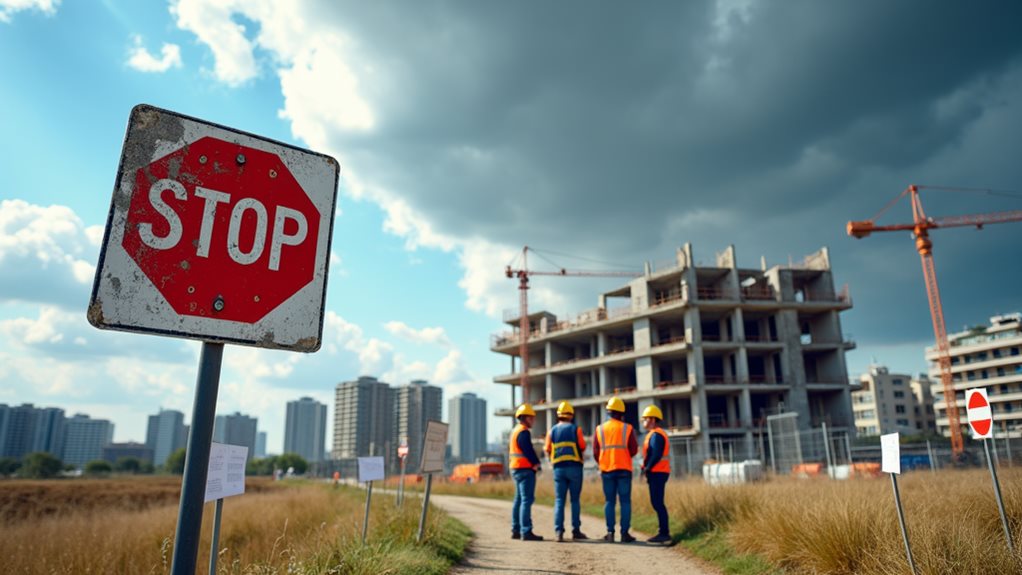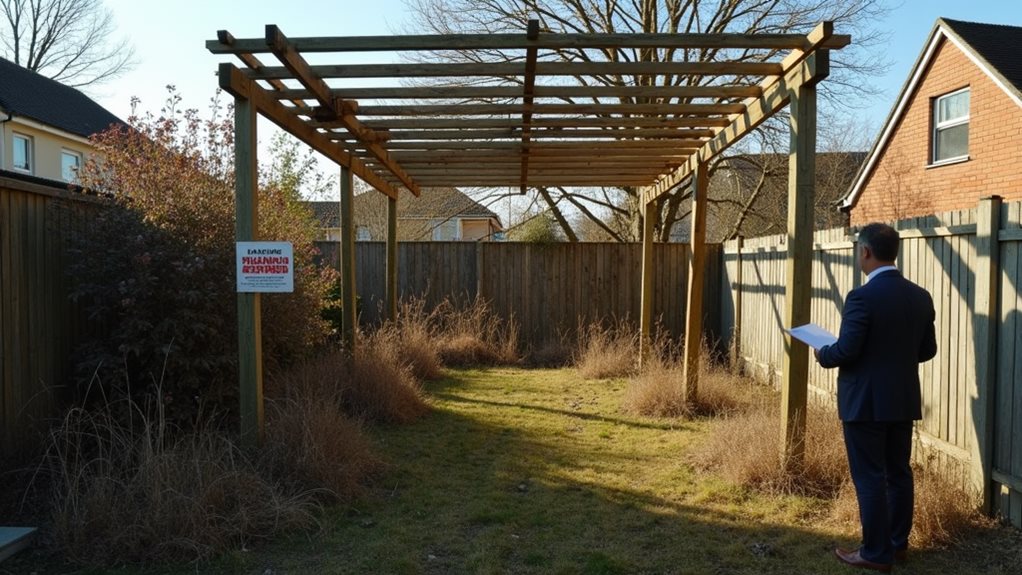Phone:
(701)814-6992
Physical address:
6296 Donnelly Plaza
Ratkeville, Bahamas.

Common planning permission issues can derail your project; discover what they are and how to avoid them for a smooth application process.
When it comes to planning permission, you might encounter several common issues that can complicate your project. First, misunderstandings around Permitted Development Rights can lead to unexpected roadblocks. Also, many local authorities have unique regulations, so you need to be aware of them to avoid penalties. Extensions typically require permission, despite what you may think. Boundary encroachments and inadequate planning can create considerable setbacks as well. It's crucial to have professional guidance throughout the application process to navigate complexities. These issues can profoundly impact your development, and there's much more to explore on how to plan effectively.

When it comes to planning permission, many people might wonder just what it entails.
You'll need to understand that planning permission is the approval you get from local authorities before starting any building or renovation project. This process guarantees that your plans align with local planning regulations and development regulations. If your project isn't considered 'exempted development,' you'll need to submit a detailed planning application that outlines your project specifics.
There are different types of planning permissions that may fit your needs. For instance, Full Planning Permission is necessary when you're ready to provide thorough designs, while Outline Planning Permission can give you a 'permission in principle' without all the design details. If you're considering small-scale alterations to your home, Householder Planning Permission would apply. Additionally, consulting your local authority can provide clarity on specific requirements and restrictions for your project.
It's crucial to know when you need planning permission. Major changes or new builds typically require it, particularly if you're in a conservation area.
Steering through this process might feel intimidating, but once you grasp these basics, you'll be better equipped to commence your project confidently. Staying informed will help you avoid unnecessary headaches down the line!
When it comes to home extensions, a lot of folks misunderstand what's actually required for planning permission.
While some smaller projects might fall under Permitted Development Rights, most extensions, including single or double-storey additions, typically need approval from your local council. It's also wise to consult with expert builders who can provide insights on navigating the planning process effectively.
It's crucial to stay informed about local policies and make certain your plans align with them to avoid any surprises later on. Planning permission is not just a formality; it ensures compliance with important building regulations that safeguard the structural integrity of your home.
Many homeowners mistakenly believe that certain extensions don't require planning permission or fall under permitted development. This misunderstanding can lead to major complications down the line.
First and foremost, if your planned extension isn't considered exempt, you'll need to apply for planning permission. There are two main planning permission types: full permission and outline permission.
It's vital to gather the required documents for your application, like site plans and proposals. The local planning authority assesses your application, factoring in environmental impacts and adherence to policies.
Don't forget to check the application fees, as they vary based on the type of development you're undertaking.
Ignoring these requirements, especially regarding size restrictions and ecological considerations, can result in potential legal consequences. You might think starting without approval is a small risk, but it could lead to significant penalties or the need to undo your work.
Although you might think that your home automatically qualifies for certain building extensions without needing planning permission, that's not always the case. Many homeowners misunderstand their permitted development rights, believing all properties enjoy the same freedoms.
But these rights come with limitations and vary based on property type and location. For instance, extensions must stay within specific sizes and comply with local planning guidelines. If your home is in a conservation area or is a listed building, permitted development rights may be restricted or entirely absent.
It's essential to check past developments as they could have used up your rights, leaving you with fewer options. Before diving into your ambitious expansion plans, consulting a qualified town planner is wise. They can clarify if your rights have been removed and help you navigate the local planning landscape.
Additionally, applying for a Lawful Development Certificate can provide you with legal confirmation about what you can do. Ultimately, keeping these considerations in mind fosters a sense of belonging within your community, ensuring your changes harmoniously contribute to the local character.

When you're maneuvering through local authority regulations, understanding the specific guidelines can save you time and hassle.
Each application you submit comes with unique requirements that you need to fulfill, ensuring you stay compliant with local rules.
Plus, being aware of enforcement actions helps you avoid potential penalties, keeping your project on track and within the law.
Maneuvering local authority guidelines is essential for anyone seeking planning permission. Understanding these local regulations isn't just about following rules; it's about ensuring your project aligns with community values and design standards.
When you approach your planning authority, be prepared to provide detailed plans that reflect the zoning laws in your area.
You'll find that different types of planning permissions cater to various project scopes. Full permissions last five years but come with conditions that may alter your original proposal. Meanwhile, outline permissions, lasting three years, require additional approvals before construction can commence.
It's also vital to involve the community. Public notice is mandatory, so be ready for objections that may arise. Local authorities will assess the environmental impact and how your project relates to neighboring properties.
Keep in mind that violating any planning permission regulations could lead to costly penalties or enforcement actions, and nobody wants that stress.
Specific application requirements are essential for successfully obtaining planning permission from local authorities. To make your life easier, it's critical to understand what's needed.
First, you must fill out the relevant application forms, tailored to your project's specifics, whether you're seeking full or outline planning permission. Remember, it's not just about completing forms; you need to meet documentation requirements too. Required paperwork includes location plans, site plans, and ownership certificates, alongside any necessary design and access statements.
Don't forget about the notice period! You'll need to give public notice through a local newspaper and site notices for at least five weeks following your application submission. This step is important for community engagement, and it also guarantees transparency in the planning process.
Also, keep an eye on fees associated with your applications; using the Planning Portal's fee calculator can help you determine the correct amount.
Steering the planning permission process isn't just about application requirements; it also involves understanding how local authorities enforce regulations. Encountering enforcement challenges can be intimidating, but knowing the types of notices can help you navigate potential pitfalls.
Here's a quick overview of notice types you might face:
Once a breach is noted, authorities conduct an investigation, which may involve site visits.
You'll have the right to appeal against any enforcement notice issued. Non-compliance can lead to serious consequences, including fines or legal proceedings against you.
Ultimately, understanding these processes and acting swiftly can make all the difference.
It's crucial to stay informed and proactive, ensuring you stay within the regulations while fostering a good relationship with your local authority. Your awareness and compliance can create a smoother planning experience for everyone involved.
While planning permission sets the conceptual groundwork for construction projects, building codes play an essential role in guaranteeing these plans translate safely into reality.
They're designed to protect public health and safety while maintaining the general welfare of the community. By addressing various factors—from structure to drainage and even energy efficiency—building codes provide a thorough framework that every project must adhere to.
You'll need to obtain a building permit after securing planning permission, as this permit confirms your project meets all the technical specifications outlined in the building codes.
Building code enforcement is critical; it includes inspections to verify compliance throughout the construction process.

Guiding through the planning permission application process can feel intimidating, but breaking it down into manageable steps makes it easier.
By understanding the common application challenges and potential process pitfalls, you'll boost your confidence as you move forward.
Here's a simplified approach to keep you on track:
When it comes to addressing your neighbors' concerns, understanding their objections is vital.
Clear communication about your plans can pave the way for productive discussions, helping to ease any anxiety they might have.
Often, neighbors have valid concerns when new planning applications are submitted in their vicinity, and understanding how to articulate these objections effectively can make a difference in the decision-making process.
By delving into neighbor concerns, you can bring attention to issues that might be overlooked by planners. Here are some objection strategies to contemplate:
Understanding neighbor objections lays the groundwork for addressing concerns through effective communication strategies. To foster a sense of community, start by engaging stakeholders early, securing their feedback even before you submit your planning application. Informal meetings allow you to discuss your plans while listening to their thoughts, creating an atmosphere of trust and collaboration.
When you're ready for the formal consultation, notify immediate neighbors, sharing specific details through letters and site notices. Set clear deadlines for comments, and encourage everyone to express their views. Remember, when you make all feedback available publicly, you show transparency in the process.
Addressing concerns related to privacy, light, and local character is vital. Make certain to provide clear information that supports your plans and counteracts objections. Consider hosting public meetings or workshops to openly discuss issues and demonstrate your willingness to adapt based on community feedback.
Finally, document all communication efforts and reviews to guarantee a smooth process moving forward. Engaging with neighbors in genuine conversation not only helps address objections but also builds a supportive community around your planning ambitions.
After all, effective stakeholder engagement is key to achieving success together.

Inadequate planning awareness can cripple a project's success from the outset. It's crucial to recognize how overlooked planning elements can lead to significant setbacks. When you fail to align project objectives with business goals, you risk wasting resources and time on efforts that don't matter.
Here are some common issues to reflect upon:
Inadequate resource planning often exacerbates these problems. Without clear roles, team members may feel overwhelmed or underutilized, leading to frustration and inefficiency.
Stakeholder engagement issues arise when you don't involve the right people early in the process, making it harder to garner support later on.
Maneuvering boundary encroachment issues can be an intimidating task for property owners, leading to conflicts that may disrupt projects and strain relationships. You might find yourself facing boundary disputes stemming from inaccurate property surveys or the lack of clear documentation defining your property lines. Misunderstanding these boundaries can turn minor misunderstandings into significant legal headaches.
To prevent such issues, consider conducting professional surveys when purchasing property so you define your boundaries accurately. Keep detailed records of any changes you make, and always guarantee compliance with local regulations. Regularly inspecting property lines can also help you spot potential encroachments early.
If a dispute arises, start with informal communication to resolve it directly before considering legal action. If negotiations don't work, legal avenues—such as injunctions or easement agreements—may become necessary. Consulting a legal expert who specializes in boundary disputes can provide you with the guidance needed to navigate these complexities with confidence.

When you initiate a building project without the necessary planning permissions, you risk facing significant challenges down the road, including the complexities of retrospective planning permission. The prospect of applying for retrospective applications can feel overwhelming, as the risks associated with these processes can be substantial.
Getting retrospective planning permission is often more complicated and costly than securing permissions upfront. If your application is refused, you may be legally required to reverse changes or face enforcement notices, which can lead to stress and additional expenses.
Additionally, local planning authorities can issue stop work orders if they identify unauthorized structures, potentially halting your project entirely.
To avoid these pitfalls, it's essential to understand local planning laws and secure the necessary approvals before diving into a project. Consulting experts can help navigate these complexities and guarantee that your dream project doesn't turn into a legal nightmare.
Save yourself the trouble by planning ahead – it truly pays off!
Traversing the complexities of planning permission can feel intimidating, but seeking professional guidance can make all the difference. By engaging in professional consultation, you guarantee regulatory compliance with local laws and policies—an essential step in maneuvering this process smoothly.
Experts, like building surveyors, possess specialized knowledge that can highlight potential challenges and provide effective solutions, ultimately increasing your chances of securing approval for your project.
Moreover, professional guidance allows you to test the waters through pre-application advice. This early feedback can save you time and effort by aligning your proposal with the planning authority's expectations.
You'll gain insights on how local regulations will be applied, reducing the risk of costly mistakes and delays. Additionally, a well-prepared application showcases your project in the best light, enhancing its appeal to local authorities.
In short, surrounding yourself with knowledgeable professionals not only streamlines your planning process but grants you peace of mind. Their expertise guarantees that your project aligns with zoning laws and safety standards, helping you feel part of a supportive community focused on successful development.
Investing in professional guidance is vital—and it might just be your smartest move.
Maneuvering planning permission can feel like walking a tightrope; one misstep and you risk falling into complications. Take the time to understand local regulations, communicate with your council, and seek professional advice. By doing this, you'll not only safeguard your project but also build a solid foundation for your vision. Remember, a well-considered approach can turn hurdles into stepping stones, leading you toward a successful outcome and a space that truly reflects your aspirations.